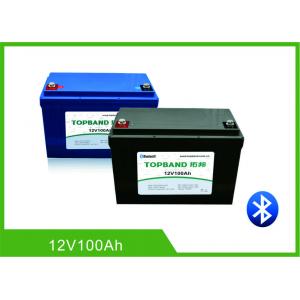

Add to Cart
1. General Information
This specification defines the performance of rechargeable LiFePO4 battery pack TB-BL12100F-SC-M110D_00 manufactured by Shenzhen Topband Battery Co., Ltd, describes the type, performance, technical characteristics, warning and caution of the battery pack. The battery pack supports Bluetooth communication function. Through Android and IOS APP, the battery status and information can be read. Especially due to the Android system’s openness, different smartphone manufacturer will have their own different Bluetooth hardware version and customized feature Android systems. So the APP may not work well on some smartphones (with Android system) due to the compatible issue. It is necessary for the customer to confirm whether the phone is compatible with the APP.
2. Specification(@Battery initial Temp25±5℃)
| NO. | Items | Criteria | Remarks |
| 2.1 | Rated Capacity | 100Ah | |
| Minimum Capacity | 95Ah | ||
| 2.2 | Energy | 1.28KWh | |
| 2.3 | Nominal Voltage | 12.8V | |
| 2.4 | Outgoing Voltage | ≥12.8V | |
| 2.5 | Internal resistance | ≤20mΩ | |
| 2.6 | Series parallel application | Max. 4pcs in series connection; Max. 4pcs in parallel connection. | |
| 2.7 | Limited charge voltage | 14.6±0.2V | |
| 2.8 | Floating charge voltage | 13.8±0.2V | |
| 2.9 | Standard charge current | ≤60A | |
| 2.10 | Maximum charge current | 80A | |
| 2.11 | Standard discharge current | 80A | |
| 2.12 | Maximum discharge current | 100A/withstand 30min @Battery initial Temp 25±5℃ | |
| 2.13 | Pulse discharge current | Withstand the 350A/3s | |
| 2.14 | Discharge cut-off voltage | 8.0V | |
2.15 | Dimension | Length: 318±2mm | |
| Width: 165±2mm | |||
| Height: 215±2mm | |||
| 2.16 | Weight | Approx: 12.4±0.5Kg | |
2.17 | Operating Temperature | Charging:0~45℃ | |
| Discharging:-20~60℃ | |||
| Recommended operating temperature:15℃~35℃ | |||
| 2.18 | Self-discharge rate | Residual capacity:≤3%/month;≤15%/years | |
| Reversible capacity:≤1.5%/month;≤8%/years | |||
| 2.19 | Storage Temperature & Humidity Range | Less than 1 month:-20℃~35℃,45%RH~75%RH | |
| Less than 3 months:-10℃~35℃,45%RH~75%RH | |||
Recommended storage environment: 15℃~35℃,45%RH~75%RH | |||
Longtime storage: If the battery need be stored for a long time, the voltage should be 13.2V (50%SOC) and stored in the condition as storage proposal. It needs at least one charge & discharge cycle every six months |
3. Test Conditions
3.1 Standard Test Conditions
3.1.1 Unless otherwise specified, all performance tests are required conducted at temperature 25℃±2℃, Humidity less than 45%~75%RH.
3.1.2 Unless otherwise specified, the tested product is required unused within two months after outgoing.
4. Product Performance
| NO. | Items | Criteria | Testing method | |
| 4.1 | Internal resistance | ≤20mΩ | 50% battery SOC state frequency of 1 KHZ ac resistance tester | |
| 4.2 | Cycle life (DOD100%) | ≥2000cycle | Discharge with the current of 0.33C until it can’t discharge, and then rest it for 1h. Charge the battery following CC (0.33C)/CV (14.6V) mode to full capacity, and then rest it for 1h. Repeat above process until fully charged capacity is no more than 80% of normal value. Accumulated times is defined as cycle life. | |
| 4.3 | Discharge Temperature Characteristics | -20℃ | ≥70% | At 25±5℃ discharge the battery with the current of 0.33C to the cut-off voltage and record charge capacity. Store the battery at various temperatures for 2h and discharge the battery with 0.33C to the cut-off voltage. |
| -0℃ | ≥80% | |||
| 25℃ | ≥100% | |||
| 55℃ | ≥95% | |||
| 4.4 | Charge Retention ability | Residual capacity≥80% | Charge the battery to full capacity and store it for 28days, and then discharge it with 0.33C to the cut-off voltage. | |
| Recovery capacity≥90% | ||||
| 4.5 | Communication Function | Bluetooth | Though, the user can read the battery system information such as voltage, current, SOC, temperature…and so on. | |
5. Protective circuit specification
The batteries are supplied with a LiFePO4 Battery Management System (BMS) that can monitor and optimize every single prismatic cell during charge & discharge, to protect the battery pack overcharge, over discharge, short circuit. Overall, the BMS helps to ensure safe and accurate running.
| NO. | Items | Content | Specification |
| 5.1 |
| Over charge | Over-charge protection for each cell | 3.90±0.04V | |
| Over-charge release for each cell | 3.60±0.04V | ||
| Over-charge release method | Under the release voltage | ||
| 5.2 | Over discharge | Over-discharge protection for each cell | 2.0±0.05V |
| Over-discharge release for each cell | 2.5±0.05V | ||
| Over-discharge release method | Charge to recovery | ||
| 5.3 |
| Over current | Discharge over current protection | 300A~500A |
| Protection delay time | 50s~200ms | |
| Over current release method | Delay about 8S after recovery | ||
| 5.4 | Short circuit | Do not short-circuit the electrodes | Designed For 500A~750A /500us |
| 5.5 | Battery temperature | Charge over temperature | Protection @65±5℃ |
| Release @50±5℃ | |||
| Discharge over temperature | Protection @65±5℃ | ||
| Release @50±5℃ | |||
| Charge low temperature protection | Protection @-10±5℃ | ||
| Release @0±5℃ | |||
| MOSFET over temperature protection | Protection @103±10℃ | ||
| Release @75±10℃ |
